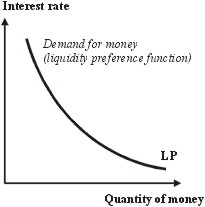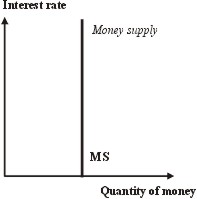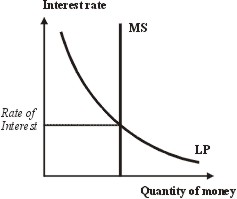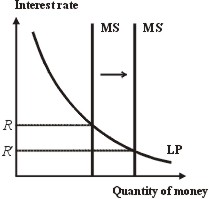|
The Money Market |
Interest rates and borrowing money |
|
Interest rates are the cost of borrowing money. If you put money into a bank (or lend it to someone) you obtain a percentage back every year — this is called the interest rate.
|
|
|
Firms need to borrow money because they wish to finance new investment. Once they have successfully borrowed money, say from a bank, they start to spend it on buying new capital goods, such as buildings, plant and machinery. Although the borrow cash, they quickly use the cash to convert this into fixed assets.
|
|
|
Consumers borrow money because they wish to buy things immediately, on credit, rather than save up for them. For example, someone might use his credit card to pay for a holiday, and pay back the money for the holiday long after going on it. Again, the money that is borrowed hardly remains as cash for long.
|
|
Demand for money — the liquidity preference function
|
|
So what does create demand for cash? According to the economist Keynes, people require cash (in this context, this means, coins, notes and credit balances at the bank) for three reasons.
|
|
| 1 | | Transactions demand. You go to a shop and pay in cash. Therefore, you need a certain amount of cash in your pocket in order to pay for the transactions you make. |
| 2 | | Precautionary demand. You are worried about the security of your job. You keep a large credit balance in your bank account in case you lose it. |
| 3 | | Speculative demand. The interest rate is low, but you think it might go up. You keep a large proportion of money in cash, just in case some tasty investment opportunity pops up. |
|
|
|
It is generally regarded that at any given time, the transactions demand and precautionary demand is fixed. The speculative demand, however, as the example suggests, is a function of the rate of interest. When interest rates are high, the temptation to speculate by holding cash decreases. The interest rate is high so why not avail of the opportunity to make a good return on it?
|
|
|
Hence, demand for money (cash) increases as the rate of interest decreases. This creates a demand curve for money, which is called the liquidity preference function.
|
|

|
|
|
The demand for money — otherwise known as the liquidity preference function.
|
|
The supply of money |
|
Here the supply of money refers to the supply of coins, notes and credit. At any given time the supply of coins, notes and credit is thought to be fixed. Therefore, the supply curve for money (called the money supply) is perfectly inelastic, that is, vertical.
|
|

|
|
|
The supply of money — at any given time the quantity of money supplied to the economy is fixed.
|
|
Determination of interest rates |
|
Interest rates are determined through the interaction of the supply and demand for money.
|
|

|
|
|
The rate of interest (that is, the cost of borrowing) is determined by the interaction of the supply and demand for money.
|
|
|
If there is an increase in the money supply, this will result in a lowering of the rate of interest.
|
|

|
|
|
An outward shift in the money supply from MS to MS? results in a decrease in the interest rate from R to R'.
|
|
Governments and interest rates |
|
Governments use interest rates mainly to control inflation. Interest rates also affect the level of investment in a country and exchange rates.
|
|
|
The rate of interest at which the government will lend to the banks is called the base rate. Governments affect the cost of borrowing by adjusting up or down the base rate.
|
|
|
When interest rates go up, the cost of borrowing increases. Firms have to pay more for money they borrow, and this discourages investment. Since investment falls, this means that there is a reduction in demand for goods and services, so this leads to a fall in total (aggregate) demand.
|
|
|
The rise in the cost of borrowing, as a result of increasing interest rates, also affects consumers. Consumers also have to pay more for shopping on credit — they pay the credit card companies a higher rate of interest, for instance. The rise in interest rates discourages consumers from spending, so consumption expenditure falls. This also leads to a fall in total (aggregate) demand in the economy.
|
|
|
The base rate is the minimum rate of interest that is charged in the country. As banks borrow from the government at this rate, they will not lend money to private individuals and firms at the base rate. If they did so, they would make no money from their actions. Consequently, when firms and individuals go to a bank in order to borrow money, they have to pay a premium above the base rate. Banks typically quote rates of interest at which they will lend to firms and individuals in terms of percentage points above the base rate.
|
|
A paradox — and its solution |
|
Supply and demand analysis suggests that the rate of interest is determined by the supply and demand for money. However, we have just seen that the government fixes the rate of interest by fixing its base rate. So we have the paradox — how can the government fix the rate of interest if in fact the rate of interest is determined by the money market?
|
|
|
The solution to this paradox is that the government does not really fix the rate of interest, it adjusts the money supply. It does this by selling government bonds. The precise mechanism for this is covered in another unit; however, if the government sells more bonds, this results in a lowering of the rate of interest. The sale of bonds creates more credit in the economy, so really, the government is not fixing the rate of interest, but adjusting the money supply. So it is the market that determines the rate of interest, but the government has a huge influence over the money supply. They announce their intention to expand the money supply by announcing a decrease in thebase rate; and, conversely, their intention to decrease the money supply by announcing an increase in the base rate; but what they are really adjusting is the number of government bonds they are prepared to sell. This resolves the apparent paradox.
|
|
|
The government's use of the base rate to control the rate of interest in the economy is called monetary policy.
|
|